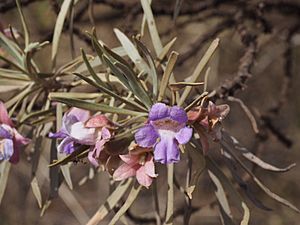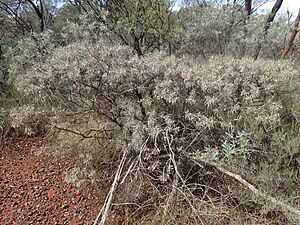Eremophila phyllopoda facts for kids
Quick facts for kids Eremophila phyllopoda |
|
|---|---|
 |
|
| Eremophila phyllopda subsp. obliqua leaves and flowers | |
| Scientific classification | |
| Genus: |
Eremophila (plant)
|
| Species: |
phyllopoda
|
Eremophila phyllopoda is a beautiful flowering plant found only in Western Australia. It belongs to the figwort family, called Scrophulariaceae. This plant is a shrub that can grow upright or spread out. It often has a round or flat top. Its leaves are sticky and hairy, and its flowers come in lovely shades of pink, lilac, or purple.
Contents
What Eremophila phyllopoda Looks Like
Eremophila phyllopoda is a shrub that can be compact and flat-topped or spread out. Its shape depends on the specific type, called a subspecies. It usually grows between 0.4 and 2 meters (about 1 to 6.5 feet) tall.
Leaves and Branches
The branches and leaves of this plant are covered with soft, silvery or dull grey hairs. Sometimes, these hairs might look a bit brown. The branches feel rough because of the leaf bases that stick out. They are also sticky because of a natural resin the plant produces.
The leaves grow one after another, but they are often grouped together near the ends of the branches. They are long and narrow, tapering at both ends. Each leaf is about 18 to 110 millimeters (0.7 to 4.3 inches) long and 1.5 to 7 millimeters (0.06 to 0.28 inches) wide. They have hairs pressed flat against their surface, which can sometimes be hidden by the sticky resin.
Flowers and Fruits
The flowers of Eremophila phyllopoda grow either alone or in pairs where the leaves meet the stem. Each flower sits on a short stalk, about 1.5 to 4.5 millimeters long. This stalk is also very hairy.
Each flower has five sepals, which are like small, leaf-like parts that protect the bud. These sepals overlap, are green to pale purple, hairy, and sticky. They are quite long, measuring 8.5 to 25 millimeters (0.33 to 0.98 inches).
The petals are joined together at the bottom, forming a tube. This tube is 13.5 to 32 millimeters (0.53 to 1.3 inches) long. The outside of the petal tube can be white, pink, deep lilac, or purple. The inside is white and filled with soft, woolly hairs. The tips of the petals are hairy on the outside but smooth on the inside. Inside the petal tube, there are four stamens (the parts that make pollen), but you can't see them because they are completely hidden.


The time when the plant flowers depends on its subspecies. After flowering, the plant produces dry, oval or cone-shaped fruits. These fruits are small, about 2.5 to 4 millimeters (0.1 to 0.16 inches) long, and have a hairy, papery covering.
How Eremophila phyllopoda Got Its Name
The plant was first officially described in 2007 by a scientist named Robert Chinnock. He published his description in a book about Eremophila plants.
The second part of the plant's scientific name, phyllopoda, comes from words that mean "leaf" and "foot." It refers to the very noticeable leaf bases that stay on the plant even after the leaves have fallen off.
Different Types of Eremophila phyllopoda
Robert Chinnock also identified two main types, or subspecies, of Eremophila phyllopoda. Both are recognized by the Australian Plant Census:
- Eremophila phyllopoda subsp. phyllopoda: This type flowers from June to October. Its leaves are longer, usually 60 to 110 millimeters (2.4 to 4.3 inches) long. Its petals are also longer, more than 24 millimeters (0.94 inches) long.
- Eremophila phyllopoda subsp. obliqua: This type flowers from June to August. Its leaves are shorter, about 18 to 50 millimeters (0.7 to 2 inches) long. Its petals are also shorter, less than 25 millimeters (0.98 inches) long.
Where Eremophila phyllopoda Grows
Subspecies phyllopoda Habitat
The phyllopoda subspecies grows on stony plains and rocky ridges. You can find it in areas from west of Mount Augustus to Meekatharra. These areas include several biogeographic regions like Carnarvon, Gascoyne, Little Sandy Desert, Murchison, and Pilbara.
Subspecies obliqua Habitat
The obliqua subspecies prefers stony soils near creek beds and on rocky hills. It is found between the Collier and Barlee ranges. This type grows in the Gascoyne and Pilbara biogeographic regions.
Protecting Eremophila phyllopoda
Good news! Both subspecies of Eremophila phyllopoda are currently considered "not threatened." This means they are not at risk of disappearing, according to the Western Australian Government's Department of Parks and Wildlife.
Growing Eremophila phyllopoda in Your Garden
This plant is one of the most attractive Eremophila species. Its grey, hanging leaves and many lilac, blue, or pink flowers make it very special. The colorful sepals stay on the plant for a long time, even after the petals fall off. This makes it a great plant for pots or containers.
To grow it, people usually use a method called grafting. This is where a piece of the Eremophila plant is joined onto the root system of another plant, often a Myoporum. It needs soil that drains water well and a spot with lots of sunshine. You only need to water it occasionally if there's a long dry spell. However, it doesn't like frost, so it needs a warm, protected place to grow.

